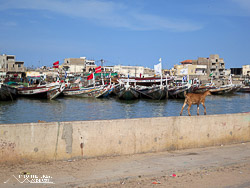Saint-Louis, Senegal
A Crumbling Colony
December 27, 2012
A broom is drearily sweeping
up the broken pieces of yesterday's life
- Jimi Hendrix

The main transport station in Dakar is essentially just a large dirt lot, stained with oil, littered with trash, wreaking of urine, and harboring some of the most ruined vehicles that can still move. Amidst this chaos there are sign-posted areas for specific destinations. I found the spot for Saint-Louis, the rusted sign jammed into an old engine block. But leaving Dakar wasn’t that as easy as the driver of the battered old minivan looked to pack more and more people inside. As everyone waited, a non-stop stream of vendors poured by, tapping on the scratched and dirt streaked windows of the van, as if we were fish in an aquarium. They were selling everything from radios, to tissues, to hand bags. Just as this became more and more annoying, the driver seemed to be satisfied as we reached 18 people. There were only 15 seats, at best.
The minivan lurched forward through the labyrinth of cars and we pulled onto the traffic congested road. After a long 5 hours the minivan finally arrived in Saint-Louis. Just from the first glance this city seemed to have a lot more character than Dakar. Saint-Louis was the capitol of France’s West Africa Federation from 1895 – 1902. The French made substantial investments in infrastructure, constructing bridges and grand colonial style houses. The capitol was moved to Dakar in 1902, since then it appears that no further money has flowed into the city at all. In a way this has been good as the city has been preserved and was never modernized. On the other hand, the city and its buildings are crumbling to the ground.

This is especially evident on the island, a narrow strip of land that contains the old historic part of the city. Walking through the mostly dirt lanes on the island you pass by abandoned buildings and buildings that look abandoned but are actually inhabited. The colonial architecture is somewhat reminiscent of New Orleans, if it had been left on its own to decay. Many buildings are homes to families, the open central courtyards serving as gathering places were goats are sometimes raised. The pace on the island is very relaxed and slow; there is none of the commotion and few of the hassles of Dakar. Residents and tourists cross paths on their various ways.
The real action in Saint-Louis, however, centers on the water. Across the bridge, past the island, is the village of Guet N’Dar. Here the narrow alleys are packed with people and are as busy as can be imagined. By the water, huge crowds of people congregate where the boats pull in and trucks are loaded up with the day’s catch. The long line of stationary white trucks stands out amongst the mass of moving people and seems to stretch to the end of the horizon. It would be hard to imagine a busier environment and yet it is also quite peaceful with many people just sitting around talking or selling things from spots on the ground.

Unfortunately, the shoreline area also seems to be the city’s garbage can. The piles of trash are enormous and the smells are even worse as the rotting trash and fish refuse create a powerful stench. Taking any pictures near the water needs to be done with speed and preferably with your breath held. There are a number of horse carts in town and the horse manure adds to this cauldron of smells. Somehow, it is actually better to stand near the fresh horse manure, as this smells much better than the rest of the rancid shoreline.
Despite the smells, the town is charming, in a run-down and dilapidated way. Especially in the late afternoon, before the sun starts to go down. Then, in the fading light, the muted colors of the decomposing old buildings transform into a pastel palette, and almost look inviting. It makes you imagine what the city must have been like in its heyday, hundreds of years ago.

That was a very different era; the factors that sustained and grew the city then are no longer around. With the capital moving to Dakar, trade waned and many people moved onward as well. Tourism and fishing seem to largely sustain the city today but may not be enough to stop the continued decline. There really does not seem to be much effort to save it or preserve it either. The spirit of the city is another matter; it seems destined to endure for a long time to come, if only the buildings will follow suit.






















































